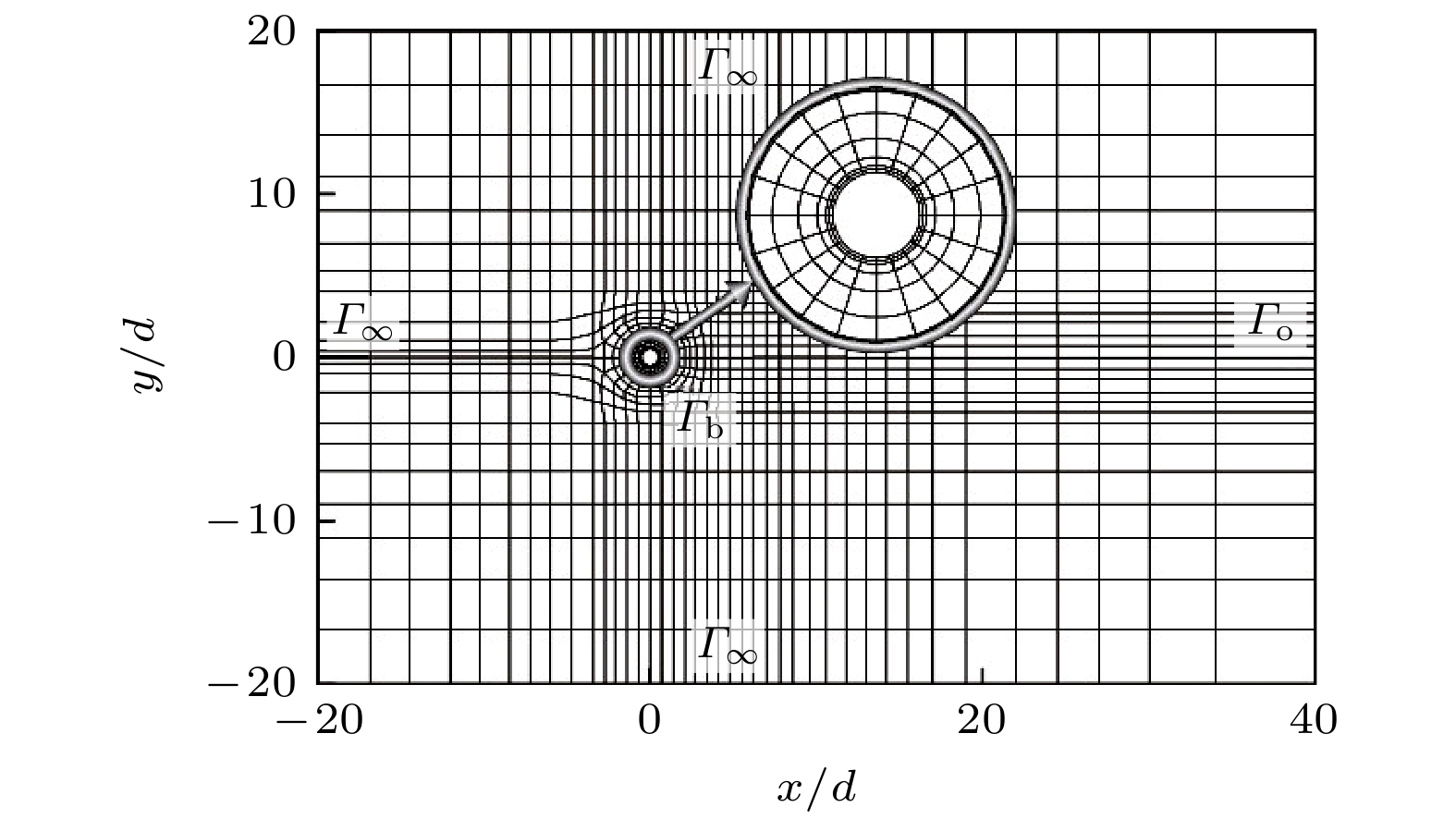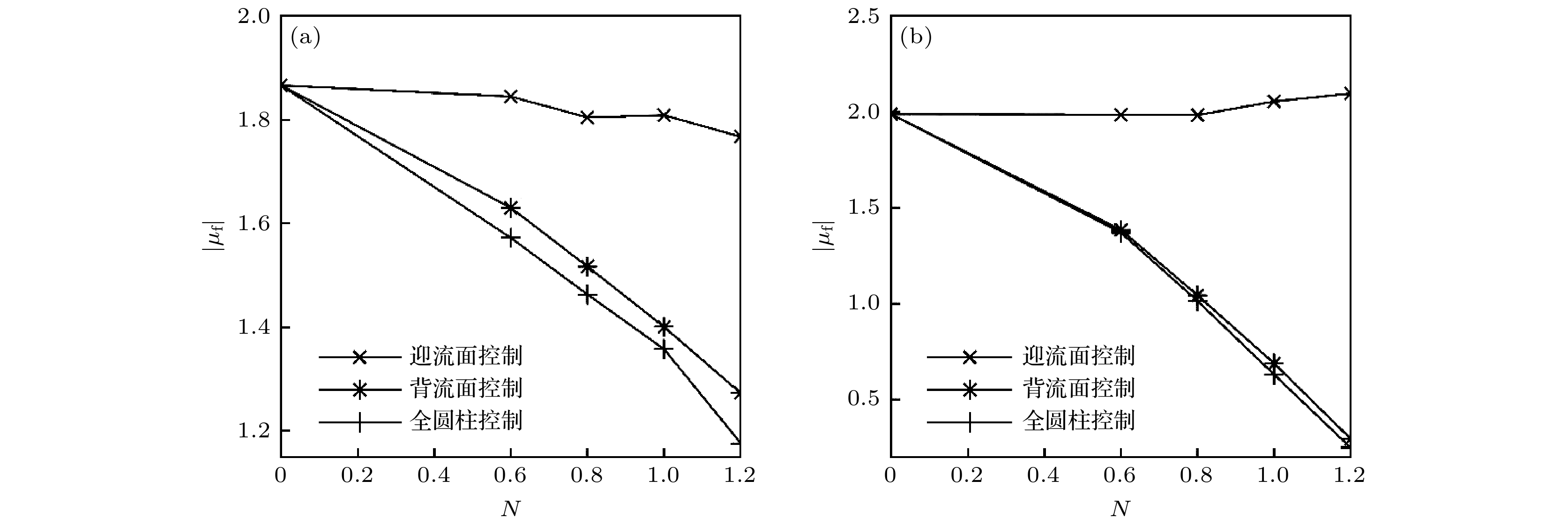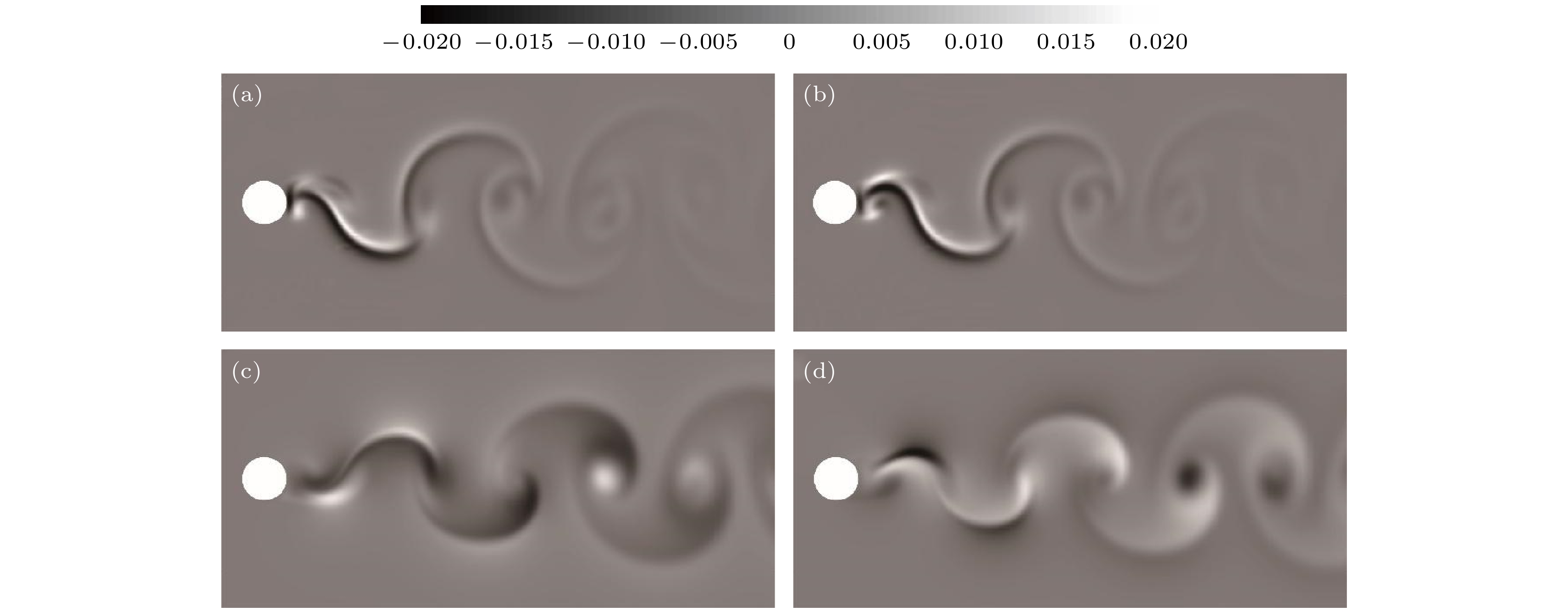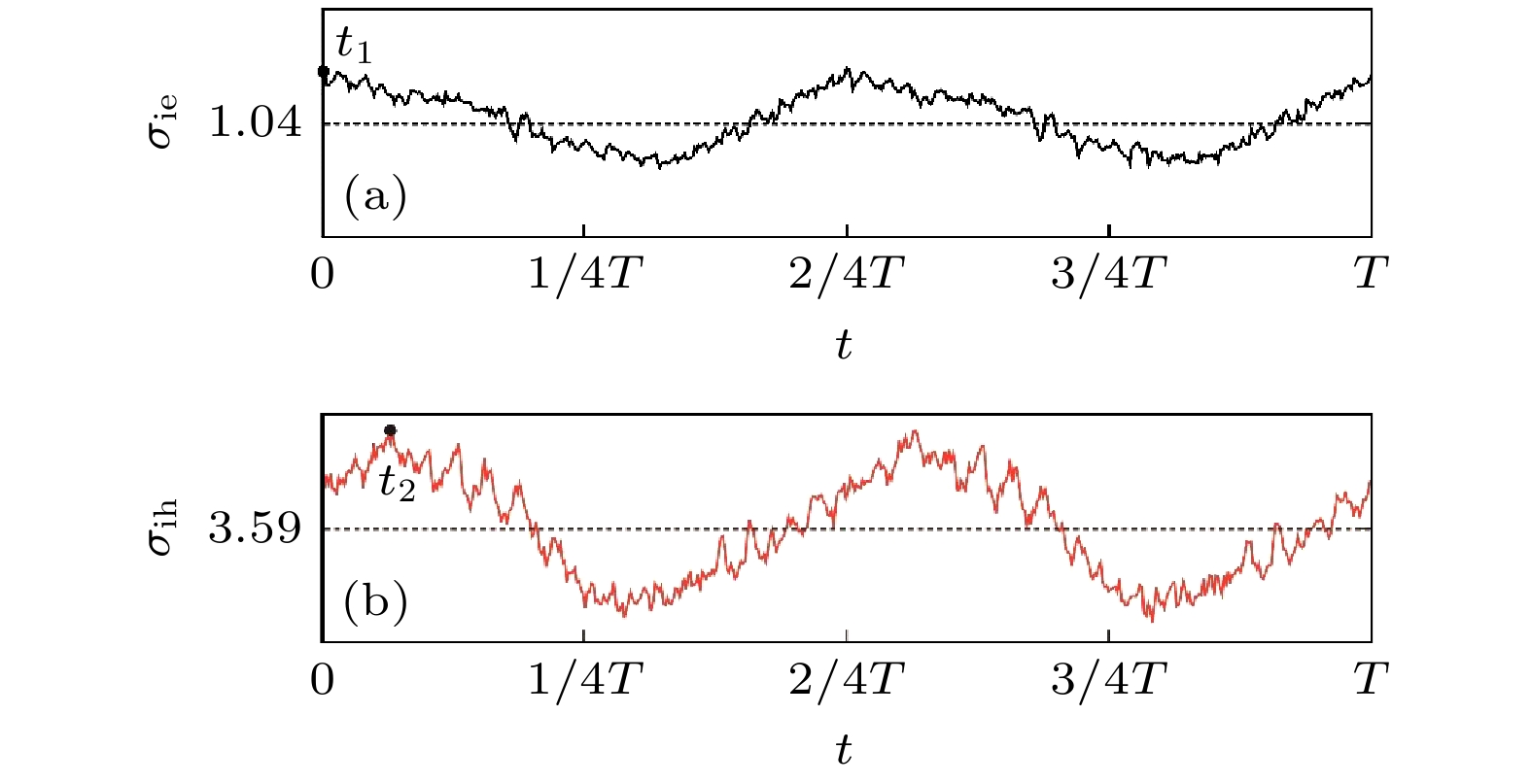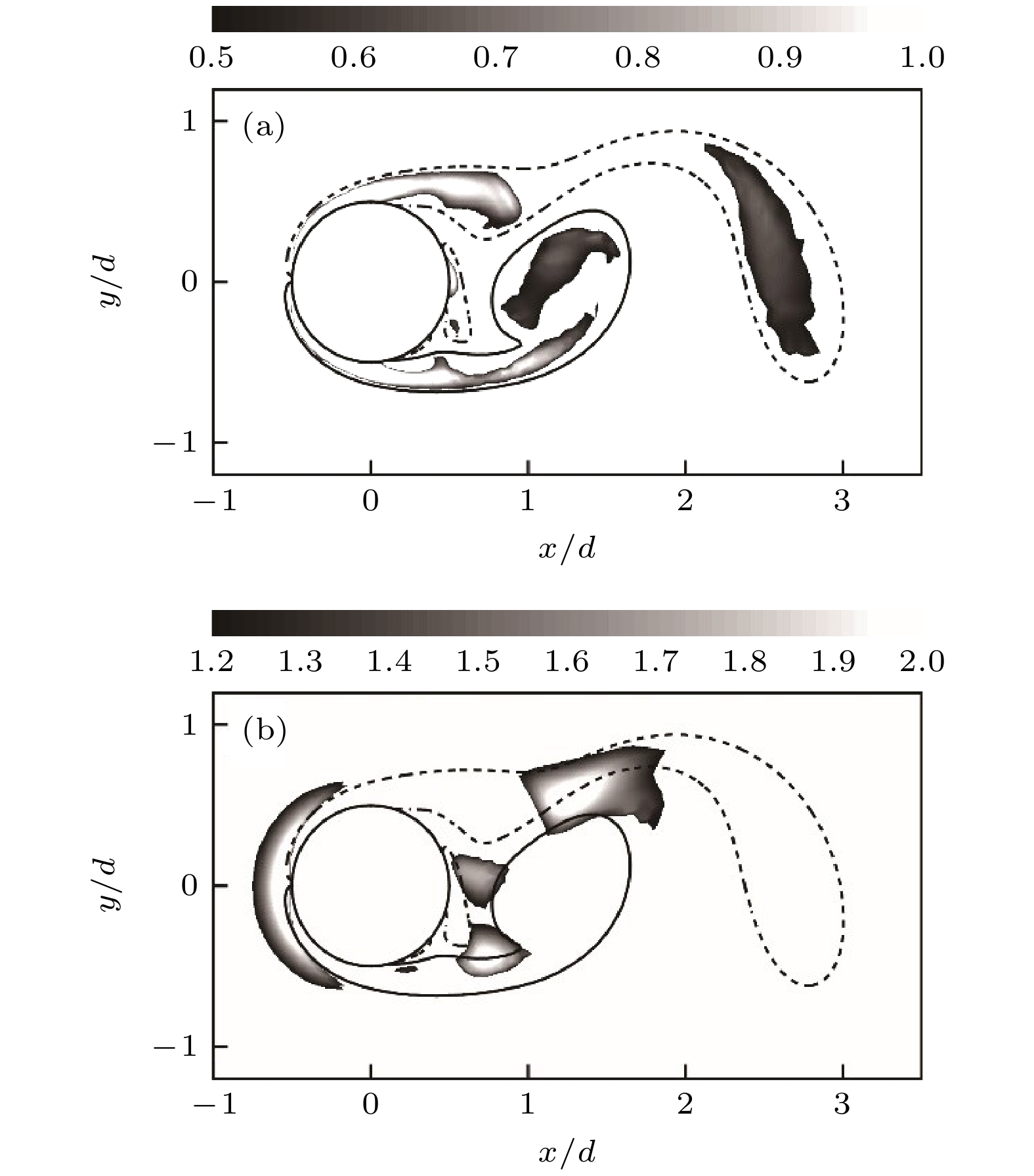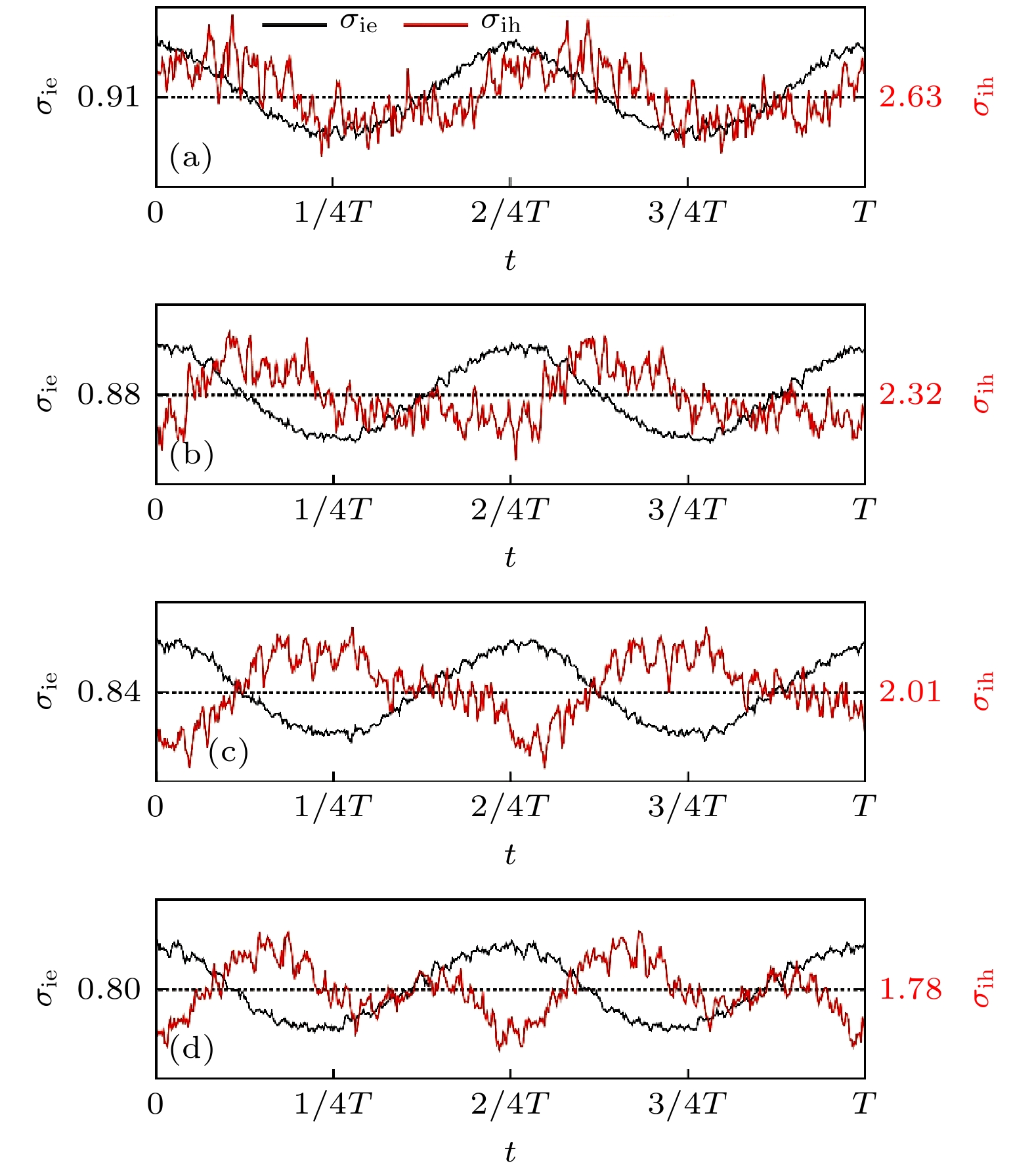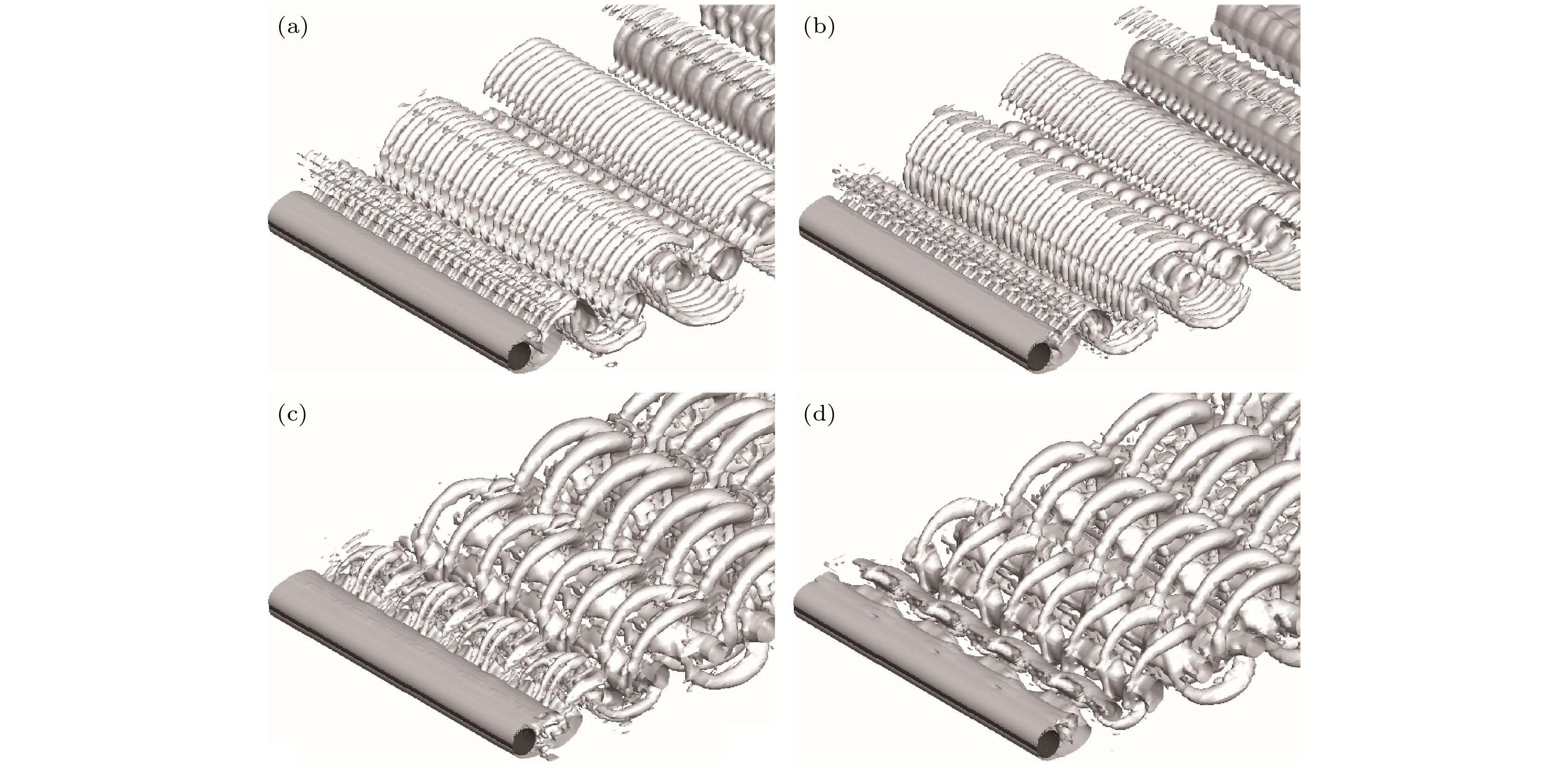-
The flow around a cylinder is a typical flow acting as the oscillator, and the perturbations can grow with time at a fixed position. This phenomenon can induce the laminar-turbulent transition in the wake, thus increasing the vibrations of the cylinder as well as the noise in the flow system. There exist three control strategies, i.e. the streamwise Lorentz force from the electromagnetic actuator set on the windward surface named windward control, the leeward surface named leeward control, and the whole surface of cylinder named global control, which are adopted to modify the two-dimensional base flow, thereby reducing the growth rates of perturbations in the wake and changing the transition mode. According to the Floquet stability analysis, it is found that the growth rates of the transition modes A and B present small changes in the windward control, while the growth rates of the two modes decrease with the increase of the control number in the other two control cases. Comparing the inviscid growth rates induced by the elliptic instability and the hyperbolic instability with each other, it is observed that the high inviscid growth rate in the windward control can be similar to those without control, while the inviscid growth rates can decrease with the increase of control number in the other two control cases. Three-dimensional direct numerical simulations are performed to validate the control effects. The results shows that the three-dimensional shape of the wake is changed from mode B to mode A when the actuator is set on the leeward surface or the whole surface of the cylinder. This is consistent with the result from the Floquet stability analysis. In addition, the drag of the cylinder reduces 15.2% for the leeward control and 14.4% for the the global control.
-
Keywords:
- cylinder wake /
- streamwise Lorentz force /
- transition control /
- flow instability
[1] Williamson C H K 1996 Annu. Rev. Fluid. Mech. 28 477
 Google Scholar
Google Scholar
[2] Jackson C P 1987 J. Fluid Mech. 182 23
 Google Scholar
Google Scholar
[3] Barkley D, Henderson R D 1996 J. Fluid. Mech. 322 215
 Google Scholar
Google Scholar
[4] Jiang H Y, Cheng L 2020 Phys. Fluids 32 014103
 Google Scholar
Google Scholar
[5] McClure J, Pavan C, Yarusevych S 2019 Phys. Rev. Fluids 4 124702
 Google Scholar
Google Scholar
[6] Xu C, Mao Y J, Hu Z W 2019 Aerosp. Sci. Technol. 88 233
 Google Scholar
Google Scholar
[7] Gao D L, Huang Y W, Chen W L, Chen G B, Li H 2019 Phys. Fluids 31 057105
 Google Scholar
Google Scholar
[8] Del Guercio G, Cossu C, Pujals G 2014 J. Fluid Mech. 752 572
 Google Scholar
Google Scholar
[9] Xu F, Chen W L, Bai W F, Xiao Y Q, Qu J P 2017 Comput. Fluids 145 52
 Google Scholar
Google Scholar
[10] Mao X R, Sherwin S 2015 J. Fluid Mech. 775 241
 Google Scholar
Google Scholar
[11] 陈蒋力, 陈少强, 任峰, 胡海豹 2022 物理学报 71 084701
 Google Scholar
Google Scholar
Chen J L, Chen S Q, Ren F, Hu H B 2022 Acta Phys. Sin. 71 084701
 Google Scholar
Google Scholar
[12] Li J C, Zhang M Q 2022 J. Fluid Mech. 932 A44
 Google Scholar
Google Scholar
[13] Marquet O, Sipp D, Jacquin L 2008 J. Fluid Mech. 615 221
 Google Scholar
Google Scholar
[14] Khodkar M A, Taira K 2020 J. Fluid Mech. 904 R1
 Google Scholar
Google Scholar
[15] Albrecht T, Stiller J, Metzkes H, Weier T, Gerbeth G 2013 Eur. Phys. J. Spec. Top. 220 275
 Google Scholar
Google Scholar
[16] Kim S, Lee C M 2001 Exp. Fluids 28 252
 Google Scholar
Google Scholar
[17] 尹纪富, 尤云祥, 李巍, 胡天群 2014 物理学报 63 044701
 Google Scholar
Google Scholar
Yin J F, You Y X, Li W, Hu T Q 2014 Acta Phys. Sin. 63 044701
 Google Scholar
Google Scholar
[18] Zhang H, Fan B C, Chen Z H 2010 Eur. J. Mech. B-Fluids 29 53
 Google Scholar
Google Scholar
[19] Zhang H, Fan B C, Chen Z H, Li H Z 2014 J. Fluids Struct. 48 62
 Google Scholar
Google Scholar
[20] Zhang H, Liu M K, Han Y, Gui M Y, Li J, Chen Z H 2017 Comput. Fluids 159 112
 Google Scholar
Google Scholar
[21] 刘宗凯, 薄昱明, 王军, 崔珂 2017 物理学报 66 084704
 Google Scholar
Google Scholar
Liu Z K, Bo Y M, Wang J, Cui K 2017 Acta Phys. Sin. 66 084704
 Google Scholar
Google Scholar
[22] Huang Y D, Zhou B M, Tang Z L 2017 Appl. Math. Mech. Engl. Ed. 38 439
 Google Scholar
Google Scholar
[23] Berger T W, Kim J, Lee C, Lim J 2000 Phys. Fluids 12 631
 Google Scholar
Google Scholar
[24] Du Y Q, Karniadakis G E 2000 Science 288 1230
 Google Scholar
Google Scholar
[25] Blackburn H M, Lee D, Albrecht T, Singh J 2019 Comput. Phys. Commun. 245 106804
 Google Scholar
Google Scholar
[26] Karniadakis G E, Israeli M, Orszag S A 1991 J. Comput. Phys. 97 414
 Google Scholar
Google Scholar
[27] Barkley D, Blackburn H M, Sherwin S J 2008 Int. J. Numer. Meth. Fluids 57 1435
 Google Scholar
Google Scholar
[28] Williamson C H K 1989 J Fluid Mech. 206 579
 Google Scholar
Google Scholar
[29] Hammache M, Gharib M 1991 J. Fluid Mech. 232 567
 Google Scholar
Google Scholar
[30] Thompsom M C, Leweke T, Williamson C H K 2001 J. Fluid Struct. 15 607
 Google Scholar
Google Scholar
[31] Jeong J, Hussain F 1995 J. Fluid Mech. 285 69
 Google Scholar
Google Scholar
-
图 10 无控制中椭圆不稳定和双曲不稳定诱导的具有最大无黏增长率的区域(云图为无黏增长率) (a)
${t_1}$ 时刻椭圆不稳定诱导; (b)$ {t_2} $ 时刻双曲不稳定诱导Figure 10. Regions with the maximum inviscid growth rates induced by the elliptic instability and hyperbolic instability: (a) Induced by the elliptic instability at
${t_1}$ ; (b) induced by the hyperbolic instability at${t_2}$ 表 1 不同插值阶数下的计算收敛性
Table 1. Convergence for different interpolation orders.
$\mathcal{K}$ ${\bar C_{\text{d}}}$ (%相对差值) ${\sigma _{\text{r}}}$ (%相对差值) 4 1.38497(–0.03) 0.14538( 0.12) 6 1.38463(–0.01) 0.14549( 0.04) 8 1.38440( 0.01) 0.14555( 0.00) 10 1.38450(—) 0.14555(—) 表 2 不同控制参数下圆柱所受平均阻力
Table 2. The average drag for different control numbers.
无电磁力控制 迎流面控制 背流面控制 全圆柱控制 N = 0.6 N = 1.0 N = 0.6 N = 1.0 N = 0.6 N = 1.0 0.6591 0.6588 0.6594 0.6153 0.5590 0.6188 0.5642 -
[1] Williamson C H K 1996 Annu. Rev. Fluid. Mech. 28 477
 Google Scholar
Google Scholar
[2] Jackson C P 1987 J. Fluid Mech. 182 23
 Google Scholar
Google Scholar
[3] Barkley D, Henderson R D 1996 J. Fluid. Mech. 322 215
 Google Scholar
Google Scholar
[4] Jiang H Y, Cheng L 2020 Phys. Fluids 32 014103
 Google Scholar
Google Scholar
[5] McClure J, Pavan C, Yarusevych S 2019 Phys. Rev. Fluids 4 124702
 Google Scholar
Google Scholar
[6] Xu C, Mao Y J, Hu Z W 2019 Aerosp. Sci. Technol. 88 233
 Google Scholar
Google Scholar
[7] Gao D L, Huang Y W, Chen W L, Chen G B, Li H 2019 Phys. Fluids 31 057105
 Google Scholar
Google Scholar
[8] Del Guercio G, Cossu C, Pujals G 2014 J. Fluid Mech. 752 572
 Google Scholar
Google Scholar
[9] Xu F, Chen W L, Bai W F, Xiao Y Q, Qu J P 2017 Comput. Fluids 145 52
 Google Scholar
Google Scholar
[10] Mao X R, Sherwin S 2015 J. Fluid Mech. 775 241
 Google Scholar
Google Scholar
[11] 陈蒋力, 陈少强, 任峰, 胡海豹 2022 物理学报 71 084701
 Google Scholar
Google Scholar
Chen J L, Chen S Q, Ren F, Hu H B 2022 Acta Phys. Sin. 71 084701
 Google Scholar
Google Scholar
[12] Li J C, Zhang M Q 2022 J. Fluid Mech. 932 A44
 Google Scholar
Google Scholar
[13] Marquet O, Sipp D, Jacquin L 2008 J. Fluid Mech. 615 221
 Google Scholar
Google Scholar
[14] Khodkar M A, Taira K 2020 J. Fluid Mech. 904 R1
 Google Scholar
Google Scholar
[15] Albrecht T, Stiller J, Metzkes H, Weier T, Gerbeth G 2013 Eur. Phys. J. Spec. Top. 220 275
 Google Scholar
Google Scholar
[16] Kim S, Lee C M 2001 Exp. Fluids 28 252
 Google Scholar
Google Scholar
[17] 尹纪富, 尤云祥, 李巍, 胡天群 2014 物理学报 63 044701
 Google Scholar
Google Scholar
Yin J F, You Y X, Li W, Hu T Q 2014 Acta Phys. Sin. 63 044701
 Google Scholar
Google Scholar
[18] Zhang H, Fan B C, Chen Z H 2010 Eur. J. Mech. B-Fluids 29 53
 Google Scholar
Google Scholar
[19] Zhang H, Fan B C, Chen Z H, Li H Z 2014 J. Fluids Struct. 48 62
 Google Scholar
Google Scholar
[20] Zhang H, Liu M K, Han Y, Gui M Y, Li J, Chen Z H 2017 Comput. Fluids 159 112
 Google Scholar
Google Scholar
[21] 刘宗凯, 薄昱明, 王军, 崔珂 2017 物理学报 66 084704
 Google Scholar
Google Scholar
Liu Z K, Bo Y M, Wang J, Cui K 2017 Acta Phys. Sin. 66 084704
 Google Scholar
Google Scholar
[22] Huang Y D, Zhou B M, Tang Z L 2017 Appl. Math. Mech. Engl. Ed. 38 439
 Google Scholar
Google Scholar
[23] Berger T W, Kim J, Lee C, Lim J 2000 Phys. Fluids 12 631
 Google Scholar
Google Scholar
[24] Du Y Q, Karniadakis G E 2000 Science 288 1230
 Google Scholar
Google Scholar
[25] Blackburn H M, Lee D, Albrecht T, Singh J 2019 Comput. Phys. Commun. 245 106804
 Google Scholar
Google Scholar
[26] Karniadakis G E, Israeli M, Orszag S A 1991 J. Comput. Phys. 97 414
 Google Scholar
Google Scholar
[27] Barkley D, Blackburn H M, Sherwin S J 2008 Int. J. Numer. Meth. Fluids 57 1435
 Google Scholar
Google Scholar
[28] Williamson C H K 1989 J Fluid Mech. 206 579
 Google Scholar
Google Scholar
[29] Hammache M, Gharib M 1991 J. Fluid Mech. 232 567
 Google Scholar
Google Scholar
[30] Thompsom M C, Leweke T, Williamson C H K 2001 J. Fluid Struct. 15 607
 Google Scholar
Google Scholar
[31] Jeong J, Hussain F 1995 J. Fluid Mech. 285 69
 Google Scholar
Google Scholar
Catalog
Metrics
- Abstract views: 6472
- PDF Downloads: 72
- Cited By: 0















 DownLoad:
DownLoad:
